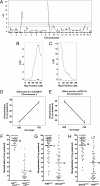Allelic variation in the Tyk2 and EGF genes as potential genetic determinants of CNS repair
- PMID: 20080754
- PMCID: PMC2818917
- DOI: 10.1073/pnas.0906589107
Allelic variation in the Tyk2 and EGF genes as potential genetic determinants of CNS repair
Abstract
The potential for endogenous remyelination and axonal protection can be an important factor in determining disease outcome in demyelinating diseases like multiple sclerosis. In many multiple sclerosis (MS) patients CNS repair fails or is incomplete whereas in others the disease is accompanied by extensive repair of demyelinated lesions. We have described significant differences in the ability of two strains of mice to repair CNS damage following Theiler's virus-induced demyelination: FVB/NJ (FVB) mice repair damaged myelin spontaneously and completely, whereas B10.D1-H2(q)/SgJ (B10.Q) mice are deficient in the repair process. A QTL analysis was performed to identify genetic loci that differentially regulate CNS repair following chronic demyelination in these strains and two QTL were detected: one on chromosome 3 with a LOD score of 9.3 and a second on chromosome 9 with a LOD score of 14.0. The mouse genes for epidermal growth factor (EGF) and Tyk2 are encoded within the QTL on chromosomes 3 and 9, respectively. Sequence polymorphisms between the FVB and B10.Q strains at both the EGF and Tyk2 loci define functional variations consistent with roles for these genes in regulating myelin repair. EGF is a key regulator of cell growth and development and we show a sevenfold increase in EGF expression in FVB compared to B10.Q mice. Tyk2 is a Janus kinase that plays a central role in controlling the T(H)1 immune response and we show that attenuation of Tyk2 function correlates with enhanced CNS repair.
Conflict of interest statement
The authors declare no conflict of interest.
Figures



Similar articles
-
A single nucleotide polymorphism in Tyk2 controls susceptibility to experimental allergic encephalomyelitis.J Immunol. 2009 Jun 15;182(12):7776-83. doi: 10.4049/jimmunol.0900142. J Immunol. 2009. PMID: 19494301 Free PMC article.
-
Genetically dominant spinal cord repair in a murine model of chronic progressive multiple sclerosis.J Neuropathol Exp Neurol. 2005 Jan;64(1):46-57. doi: 10.1093/jnen/64.1.46. J Neuropathol Exp Neurol. 2005. PMID: 15715084
-
Influence of deletion of T cell receptor V beta genes on the Theiler's virus model of multiple sclerosis.Autoimmunity. 1994;19(4):221-30. doi: 10.3109/08916939409071347. Autoimmunity. 1994. PMID: 7578848
-
Immune promotion of central nervous system remyelination.Prog Brain Res. 1994;103:343-55. doi: 10.1016/s0079-6123(08)61148-6. Prog Brain Res. 1994. PMID: 7886217 Review.
-
Genetic analysis of CNS remyelination.Curr Top Microbiol Immunol. 2008;318:177-92. doi: 10.1007/978-3-540-73677-6_7. Curr Top Microbiol Immunol. 2008. PMID: 18219818 Review.
Cited by
-
Epidermal Growth Factor in the CNS: A Beguiling Journey from Integrated Cell Biology to Multiple Sclerosis. An Extensive Translational Overview.Cell Mol Neurobiol. 2022 May;42(4):891-916. doi: 10.1007/s10571-020-00989-x. Epub 2020 Nov 5. Cell Mol Neurobiol. 2022. PMID: 33151415 Free PMC article. Review.
-
Simian immunodeficiency virus infection in the brain and lung leads to differential type I IFN signaling during acute infection.J Immunol. 2011 Apr 1;186(7):4008-18. doi: 10.4049/jimmunol.1003757. Epub 2011 Mar 2. J Immunol. 2011. PMID: 21368232 Free PMC article.
-
Resilience in Long-Term Viral Infection: Genetic Determinants and Interactions.Int J Mol Sci. 2021 Oct 21;22(21):11379. doi: 10.3390/ijms222111379. Int J Mol Sci. 2021. PMID: 34768809 Free PMC article.
-
Genetic control of alphavirus pathogenesis.Mamm Genome. 2018 Aug;29(7-8):408-424. doi: 10.1007/s00335-018-9776-1. Epub 2018 Aug 27. Mamm Genome. 2018. PMID: 30151711 Free PMC article. Review.
-
New Epidermal-Growth-Factor-Related Insights Into the Pathogenesis of Multiple Sclerosis: Is It Also Epistemology?Front Neurol. 2021 Nov 26;12:754270. doi: 10.3389/fneur.2021.754270. eCollection 2021. Front Neurol. 2021. PMID: 34899572 Free PMC article. Review.
References
-
- Kantarci OH, Weinshenker BG. Natural history of multiple sclerosis. Neurol Clin. 2005;23:17–38, v. - PubMed
-
- Lucchinetti C, et al. Heterogeneity of multiple sclerosis lesions: Implications for the pathogenesis of demyelination. Ann Neurol. 2000;47:707–717. - PubMed
-
- Lucchinetti CF, Parisi J, Bruck W. The pathology of multiple sclerosis. Neurol Clin. 2005;23:77–105, vi. - PubMed
-
- Pittock SJ, Lucchinetti CF. The pathology of MS: New insights and potential clinical applications. Neurologist. 2007;13:45–56. - PubMed
-
- Patrikios P, et al. Remyelination is extensive in a subset of multiple sclerosis patients. Brain. 2006;129:3165–3172. - PubMed
Publication types
MeSH terms
Substances
Grants and funding
LinkOut - more resources
Full Text Sources
Other Literature Sources
Molecular Biology Databases

